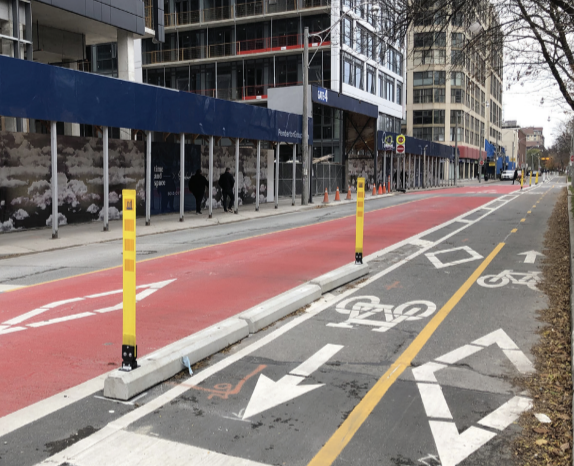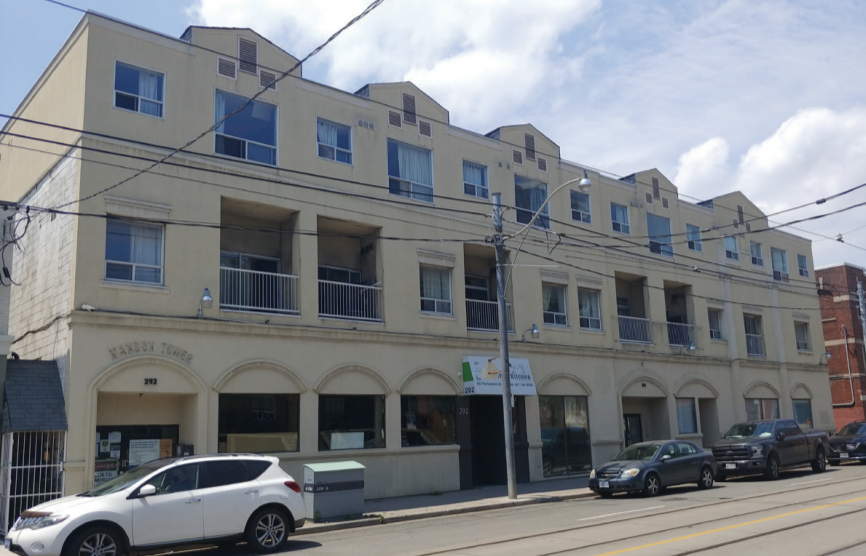
By Megan Camlasaran
–
New bike lanes from Lower Sherbourne Street to Bayview Avenue, part of road safety upgrades, are helping local people feel safer and more inclined to walk or cycle. The city has proposed protected bike lanes, designated TTC lanes, and reducing speed limits from 40 to 30 kilometres per hour.
Movement patterns will change on The Esplanade between Jarvis and Berkeley Streets, and on Mill Street between Parliament and Cherry Streets. These are important connections to St. Lawrence Market, the Distillery District and parks like Corktown Common and David Crombie Park. Pedestrians can now walk freely along sidewalks without fear of being clipped by cyclists trying to avoid vehicular traffic.
“Cyclists used to come down the sidewalks thinking ‘well I belong here too,’” said Alan Barthel, president of Longboat Area Residents Association, who himself bikes throughout the community.
“The traffic fatality last year at the corner of Mill and Cherry, and the many near-misses at Parliament and Cherry, have shown us how dangerous the streets in our area have become,” said Diana Belshaw, chair of Gooderham and Worts Neighbourhood Association. “Traffic has been reduced and slowed considerably since the changes.”
The city reported 342 collisions on The Esplanade and Mill Street from 2015 to 2019, with 10 per cent involving pedestrians and cyclists.
City working to improve signage and lane markings
Barthel said he’s almost been clipped as a pedestrian because motorists are speeding through red lights. “A few entitled drivers think these streets belong to them. We have to get them used to the fact they have to share the road, and they can’t park wherever they want.”
Robert Jordan, an employee at Ginkgo Floral Design on the Esplanade, said pedestrians had to be “very cautious” about speeding drivers, but now the road has less traffic. He sees seniors on motorized scooters taking advantage of the bike lanes, instead of having to share the sidewalk with walking pedestrians.
A city cycling study reported that most cyclists feel safer when dedicated bike infrastructure protects them from cars and trucks.
Also, “it’s better for drivers when traffic is much less,” Barthel said. “Especially if you live in the neighbourhood and use the Esplanade, not as a raceway to get home much faster.”
But Belshaw says some drivers aren’t happy about “having to go around the block ” when arriving at or exiting parking garages.
“Toronto and other cities seem to want to continue a war on cars and push people to ride bikes,” said Brenda MacDougall, an Esplanade resident who drives. “That’s great in some climates, but did we ask for this? Bike lanes are great in some areas, but not when they impede traffic and make people’s lives hard or negatively impact businesses.”
West of Jarvis, pubs, condos and stores have loading docks on the Esplanade. With the street now one way, MacDougall worries that businesses will face loading challenges.
“Taking away access to places to stop on both sides is impossible in our minds. People have lives to lead, jobs to get to and from, errands to run. They need cars. They aren’t going to switch. They can’t,” she said.
Drivers from outside the area may become confused over which lanes can or cannot be used, and which roads are now a dead end.
The city says it is working with Toronto Police and the TTC to improve signage and lane markings to safely direct people. Traffic agents on the streets are helping direct drivers. The project team is also working with Waze, Google and Apple to update their mapping software.
These roadway changes offer more space to walk and cycle on, which is expected to help the city reduce its carbon footprint as automobile dependency decreases. In the decade up to 2019, Toronto residents who cycle to work, school or for social gatherings increased from 29 per cent to 44 per cent, according to a city cycling study.
“Developing an integrated cycling network is one way to do this, and we’re pleased our community is part of this positive change,” said Belshaw.
Phase two will begin next spring, and is projected to finish in 2024.



